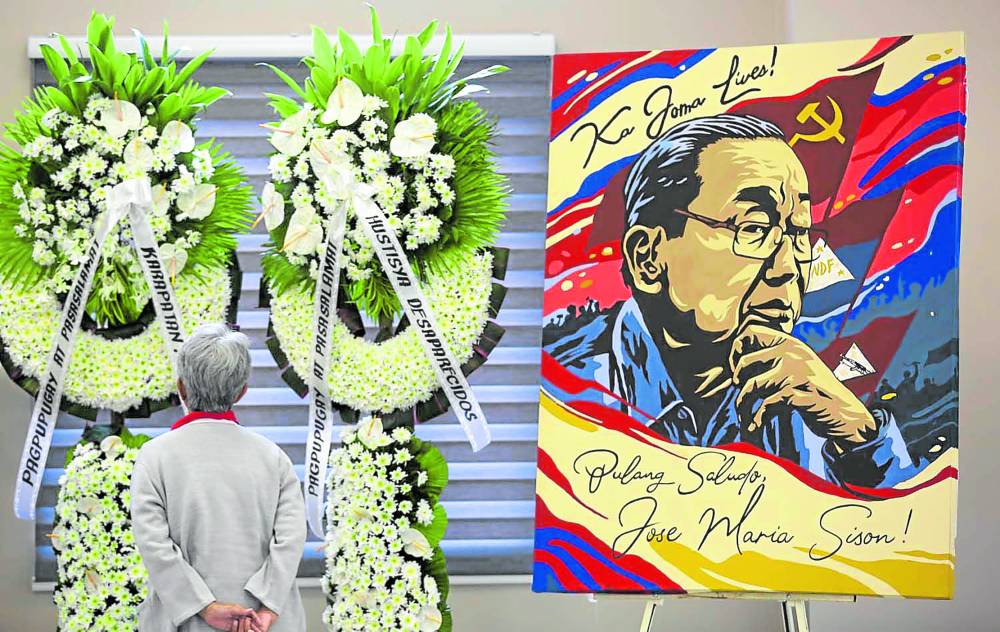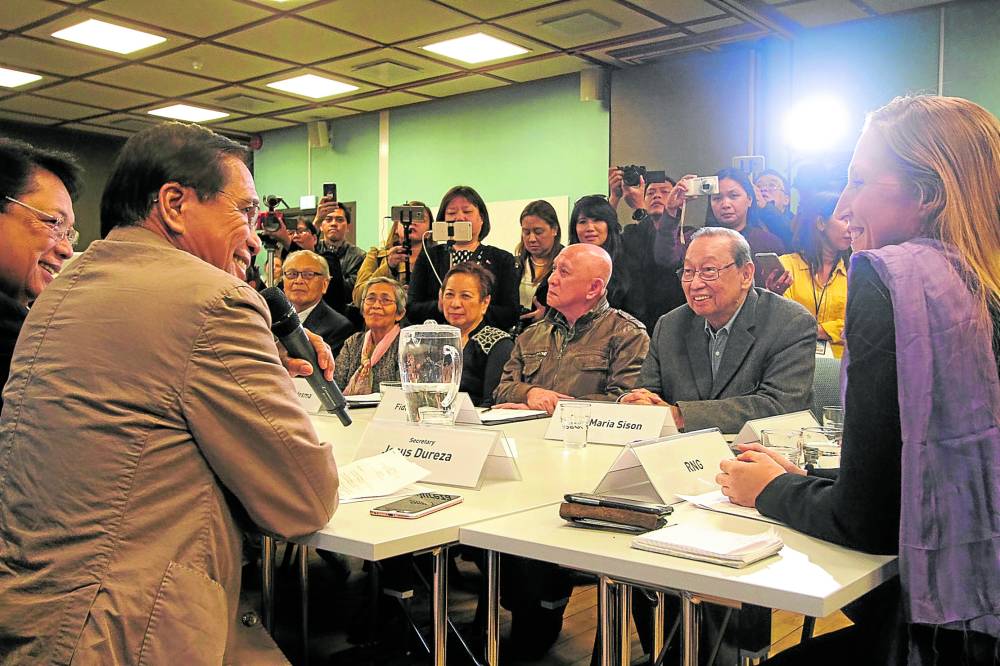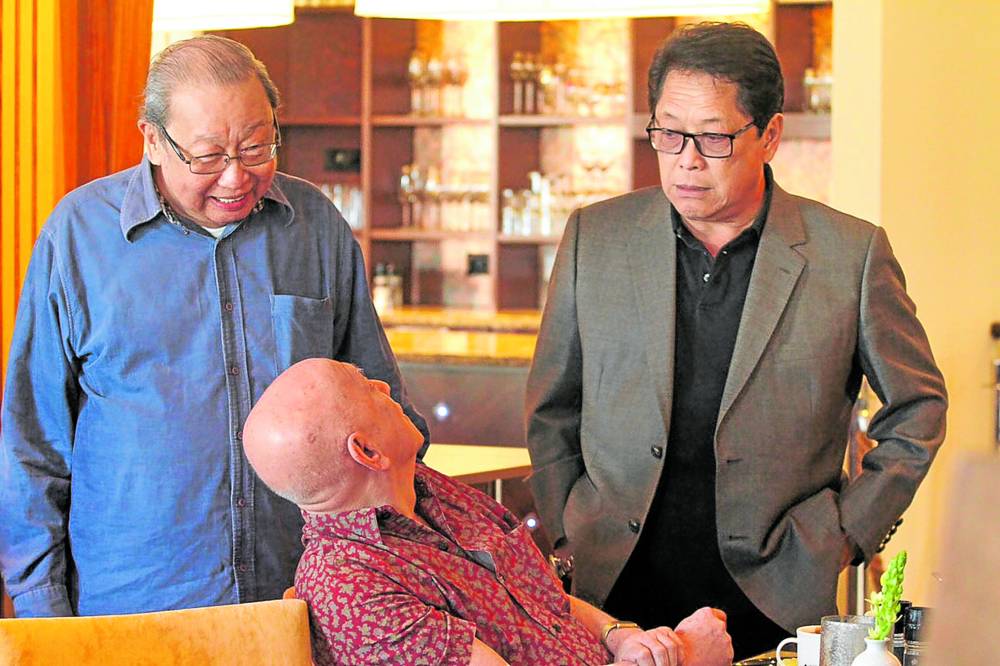‘Mischievous’ Joma yearned for home, sweet mangoes

FAREWELL The late Communist Party of the Philippines founding chair Jose Maria Sison is remembered by his supporters through a tributeheld at the University of the Philippines Student Union Building in Quezon City on Dec. 20. —NIÑO JESUS ORBETA
DAVAO CITY—While queuing for check-in at Leonardo Da Vinci Airport in Rome in January 2017 after the third round of talks between the government and the National Democratic Front of the Philippines (NDFP) under the administration of then President Rodrigo Duterte, Jose Maria Sison was seen limping and touching one of his knees.
The Communist Party of the Philippines (CPP) founding chair, the NDFP’s chief political consultant in the talks, was given an earful for munching on “peanuts” during the negotiations, which could have caused the pain.“Those were not peanuts. Those were almonds,” Sison mischievously retorted.
Sison, who stood at 1.72 meters (5 feet and 8 inches), then showed that he was in tiptop condition by stretching and moving his limbs.
When the flight to Amsterdam was called for boarding an hour later, a visibly embarrassed Sison appeared in a wheelchair. To make it more awkward, he had to pass by the NDFP delegation who had heard him showing off earlier.
“I’ll go ahead,” he chuckled. For sure, Sison did not touch the nuts served during the flight.
Article continues after this advertisementAmid his stern image as a revolutionary, Sison was also full of mischief, which demystified his public aura as the leader of the CPP that has challenged state power since 1969 when it formed its armed wing, the New People’s Army (NPA).
Article continues after this advertisement
Sison with the National Democratic Front of the Philippines’ (NDFP) panel during the second round of peace talks with the government in Oslo, Norway, in October 2016. —AND KARLOS MANLUPIG
Hopeful of peace deal
The third round of Norwegian-facilitated negotiations to end over four decades of Maoist-style rebellion was moved from Oslo to Rome where the temperature was bearable for the communist movement’s aging leaders.
The on-and-off talks since 1987 went full steam under Duterte, an avowed socialist, giving Sison some glimpse of a possible homecoming.
Sison, who has been based in Utrecht, the Netherlands, since going into a self-imposed exile in 1987, genuinely believed in the possibility of reaching a peace agreement with the government. Although having some difficulty in hearing, he was active in the formal peace negotiations and engaged in bilateral phone meetings with Duterte.
In January 2017, Sison projected that an end to the hostilities could be achieved by 2020 if both sides continued in the pace and direction of the negotiations at that time.
In September 2016, about four months before the Rome meeting, Duterte rolled out the red carpet in Malacañang for top Red leaders, deepening the goodwill and trust among the negotiating parties. The following month, the parties agreed on a framework for social and economic reforms, the bedrock of the envisioned political settlement.
But lingering differences over, among others, the timing of a bilateral truce and the release of political prisoners, led to the breakdown of negotiations, with the government pulling out from the process by November 2017.

TALKING PEACE NDFP chief
political consultant Jose Maria Sison huddles with NDFP negotiating panel chair Fidel Agcaoili (seated) and then Labor Secretary Silvestre Bello III,
the government negotiating panel chair, during backchannel talks
in the Netherlands in 2017
to inject steam into
the formal negotiation
process amid several hitches. —KARLOS MANLUPIG
Not closing doors
The collapse of the peace talks was a heavy blow for Sison who was optimistic that a peace deal could be clinched with the Duterte administration.
The ensuing word war between Sison and his former student, Duterte, escalated, which translated into more hostilities on the front lines. But despite his pointed public statements, Sison extended an olive branch to the government to allow backchannel negotiations.
“The CPP, NPA and NDFP remain committed to the peace process in accordance with The Hague Joint Declaration and further agreements. They wish to pursue with the GRP (Government of the Republic of the Philippines) the bright prospects that started with the first round of formal talks in August 2016 and overcome the peace spoilers that run counter to the progress that has been achieved in the third round of formal talks,” Sison said.
In several interviews with the Inquirer, Sison said that he would never close his doors to peace negotiations.
At the height of the negotiations, several arrangements were prepared to allow Sison’s travel to the Philippines. He was explicitly excited about eating sweet mangoes for his homecoming.
It did not, and will not happen, as Sison died last week, on Dec. 16, in a hospital in Utrecht. The CPP announced a 10-day mourning period for its founder. Reports said Sison’s remains would be cremated in Utrecht on Dec. 27.
Although amiable in person, the name Jose Maria Sison can be a polarizing topic in discussions as he has earned followers and enemies in a conflict that has now stretched for over half a century.
Polarizing figure
For his enemies, Sison was seen as the fierce and unyielding last remaining figurehead of communism across the globe, his hands bloodied for every death from an NPA attack. In military slideshows, he was presented as a bloodthirsty enemy.
But among his followers, he is legendary—a beacon of ideological astuteness who provided analyses and statements from Utrecht that guided their revolutionary work, even as he was no longer directly leading the CPP and its organs.
The CPP’s Second Congress in 2019 gave its highest honors to Sison, describing him as a “great communist thinker, leader, teacher and guide of the Filipino proletariat and torch bearer of the international communist movement.”
For journalists who cover peace and security in the country, interviewing Sison is a significant item off the bucket list. The experience is extra special for younger journalists born after the martial law period who have only heard his name in history classes.
Sison was always cited by NPA guerrillas and local communist leaders in interviews with the media. He would be referred to as “Ka Joma,” “Sison” or “JMS.”
The NPA in Mindanao jokingly referred to him as “tigulang” or old fellow, which is also an honorific in deference to his age and the long years dedicated to the national democratic struggle espoused by the CPP.
Social media geek
A journalist’s first one-on-one interview with Sison can be stressful. It can be partly due to fear and partly due to awe. The fear can be attributed to his fiery tongue, temper and excellent writing skills.
The challenge, however, is not how to begin the interview but how to end it because he will talk about anything with extreme passion.
Sison was like a walking history book. He would mention many names, dates, locations and data. He would verbalize terminologies that sounded unfamiliar and intellectual. Thanks to Google, journalists can quickly search online and pretend they understand what he is talking about.
Just like many people, Sison got hooked on Facebook, which may not be characteristic of his age. While he was able to use it for political purposes, Sison was also overly active online, posting and commenting about random stuff. He was a “patola” (coined from the Filipino “patol” or roughly, one who always responds to comments) who would engage in online discourses.
But last February, Sison’s social media account, which he maintained since 2009, had been disabled by Facebook. This also denied him the use of the Messenger app which he said hampered his communication with family, friends and various political constituencies.
Sison decried as arbitrary the company’s action which he blamed on the government’s campaign to deny him access to the extremely popular platform.
Dream for people
Because of the incident, he vowed to join a collective action lawsuit against Facebook to compel it to be recognized as a public domain that should be owned and controlled by its users. “Facebook must be collectivized,” Sison argued in a YouTube video last April.
His Twitter account was suspended along with several others on June 4, in a further crackdown against netizens who purvey dissent, especially those identified with the communist movement.
Duterte, in a Dec. 17 statement, said Sison’s demise “marks the end of an era” that saw his radical ideas “affected the course of our country’s history and birthed a movement that carries on to this day.”
The former president added: “While Mr. Sison and I have had many disagreements—especially in the ways in which he chose to pursue and effect change in the country—I would like to believe that, at the end of the day, we shared the same dream of creating a better future for every Filipino.”
—WITH A REPORT FROM RYAN D. ROSAURO
(Editor’s Note: The author covered the communist insurgency in Mindanao and the peace talks between the government and the National Democratic Front of the Philippines when these reopened under the Duterte administration from 2016 to 2017.)